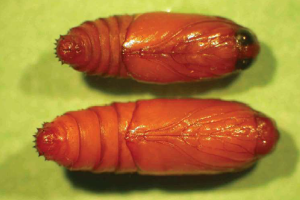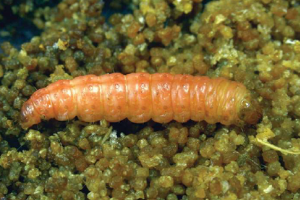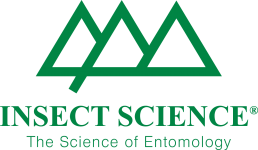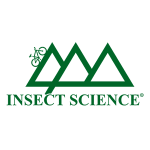Host plants
About 24 cultivated plants and more than 55 wild plants are listed as hosts of FCM. However, some of these associations have only been observed in the laboratory and are therefore questionable. The most important cultivated hosts of FCM are citrus, stone fruit, avocadoes, pomegranates, persimmons, macadamias and hot peppers, with cotton, maize, grapes and litchis being hosts of lesser importance.
Damage
Fresh larval penetration holes in fruit can only be found through thorough inspection. In green citrus fruit, the peel around the penetration hole eventually assumes a yellow colour. On ripe fruit this area is initially orange-coloured, but can eventually become sunken and brown as the damaged tissue decays. The mature larvae enlarges the original hole sufficiently to leave the fruit and pupate. Granular excreta can be found within the larval tunnels in the fruit. An infested fruit usually falls from the tree 3-5 weeks after penetration by larva. In the packhouse it is difficult to identify fruit that has been infested shortly before harvest and will result in post-harvest decay. Damage symptoms will differ subtly between different hosts.
FCM occurs in all citrus production areas of southern Africa. However, pest abundance varies dramatically in these regions and is generally lower in the far northern regions and the eastern Free State. Naval oranges are the most susceptible citrus cultivar. Mid-season varieties, certain mandarin types such as Satsumas, Star Ruby grapefruit and Turkey Valencias, can also be severely infested. Most other Valencias and white grapefruit are seldom subject to serious attack. However, Valencias can harbour FCM from one season to the next. Lemons have always been considered unsusceptible. Although there is no risk of infestation in fruit harvested for export, significant levels of infestation have been recorded in overripe and marble sized fruit, indicating the potential risk that lemons can hold for more susceptible cultivars planted nearby. The main reason for FCM’s high pest status is not the economic losses which result, but the quarantine status of the pest due to its endemism to sub–Saharan Africa.
Life history
Female moths lay their eggs singly on the surface of the fruit. Within a few days, the egg hatches and the neonate larva finds a suitable place to penetrate the fruit. All five instars of larval development take place within the fruit. Once the final (fifth) instar is ready to pupate, it exits the fruit and drops to the ground, where it spins a cocoon and pupates in the top layer of soil. The moth emerges within a couple of weeks to continue the life cycle. The full life cycle takes anything from five weeks to three months, depending on the time of the year and associated temperature, there are approximately six overlapping generations within a year. There is no winter diapause.
Natural enemies
The most effective biological suppression of FCM is provided by the egg parasitoid Trichogrammatoidea cryptophlebiae Nagaraja (Trichogrammatidae). This indigenous wasp occurs naturally in all citrus-producing regions and if disrupted, can parasitize more than 80% of FCM eggs from shortly after mid-summer. This level of parasitism has been shown to significantly reduce FCM levels in an orchard. There are also several species of naturally occurring larval parasitoids that play a role in suppressing the pest. Most of these are wasps but a few are flies. Probably the most effective of these parasitoids is the wasp Agathis bishop (Nixon) (Braconidae), which has been shown to parasitize up to 40% of FCM larvae in the Eastern Cape.
Oruis bugs (Anthocoridae) have been noted to prey on FCM eggs and assassin bugs (Reduviidae) can attack FCM larvae. However, probably the most effective predators are ants, which have been shown to dramatically reduce survival of planted FCM pupae in research trials.
Two species of entomopathogenic fungi and two virus species have also been recovered from FCM larvae. However, the Cryptophlebia leucotreta granulovirus (CrelGV) is the only pathogen for which there is evidence of a natural suppressant effect on FCM in the field.
Management
Pheromone-based trapping systems have been developed to provide a means to monitor populations levels. Dispensers are loaded with the female pheromone which attracts male moths to the trap. This trapping system was originally developed to aid in deciding whether or not chemical intervention is required for the control of FCM. However, due to the phytosanitary status of FCM for most export markets this has changed. No longer should economic thresholds be applied for export citrus, but FCM should be controlled to as close to zero levels as possible. The purpose of trapping is now therefore: to compare FCM activity levels between orchards, which will enable prioritisation of treatment application; to assist in the accurate timing of treatment application – particularly relevant to virus products. A peak in moth activity should be followed by a peak in FCM-induced fruit drop 3-5 weeks later. Fruit drop surveying is the most important means of monitoring FCM. This is the only way in which one can truly gauge the extent of the FCM situation in a particular orchard and hence the risk for post-harvest infestation and fruit decay. The effectiveness of the chosen control programme can also be measured. One can then determine whether any further control measures are required.
Orchard sanitation and biological control should form the cornerstone of FCM management. Orchard sanitation constitutes the regular collection, removal and destruction of all infested and damaged fruit from an orchard. Natural control mainly pertains to the conservation and possible augmentation of the egg parasitoid, T. cyrptophlebiae.
The CrleGV virus is commercially produced and used widely as an effective IPM-compatible means of suppressing FCM levels. Other biorational means of controlling FCM are mating disruption, attract and kill and the sterile insect technique. There is a range of chemicals registered and available for controlling FCM. These should be used judiciously in order to reduce the impact on natural enemies and the possibility of resistance.








